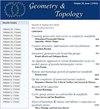The induced metric on the boundary of the convex hull of a quasicircle in hyperbolic and anti-de Sitter geometry
IF 2.2
1区 数学
引用次数: 9
Abstract
Celebrated work of Alexandrov and Pogorelov determines exactly which metrics on the sphere are induced on the boundary of a compact convex subset of hyperbolic three-space. As a step toward a generalization for unbounded convex subsets, we consider convex regions of hyperbolic three-space bounded by two properly embedded disks which meet at infinity along a Jordan curve in the ideal boundary. In this setting, it is natural to augment the notion of induced metric on the boundary of the convex set to include a gluing map at infinity which records how the asymptotic geometry of the two surfaces compares near points of the limiting Jordan curve. Restricting further to the case in which the induced metrics on the two bounding surfaces have constant curvature $K \in [-1,0)$ and the Jordan curve at infinity is a quasicircle, the gluing map is naturally a quasisymmetric homeomorphism of the circle. The main result is that for each value of $K$, every quasisymmetric map is achieved as the gluing map at infinity along some quasicircle. We also prove analogous results in the setting of three-dimensional anti de Sitter geometry. Our results may be viewed as universal versions of the conjectures of Thurston and Mess about prescribing the induced metric on the boundary of the convex core of quasifuchsian hyperbolic manifolds and globally hyperbolic anti de Sitter spacetimes.双曲和反德西特几何中拟圆凸壳边界上的诱导度规
Alexandrov和Pogorelov的著名工作精确地确定了在双曲三维空间的紧凸子集的边界上诱导球上的哪些度量。作为推广无界凸子集的一个步骤,我们考虑了由两个适当嵌入的圆盘所包围的双曲三维凸区域,它们沿理想边界上的Jordan曲线在无穷远处相交。在这种情况下,很自然地在凸集的边界上增加诱导度量的概念,以包括无穷远处的粘合映射,该映射记录了两个曲面的渐近几何如何比较极限乔丹曲线的近点。进一步限制两个边界面上的诱导度量具有常曲率$K \in[-1,0)$,且无穷远处的约当曲线是准圆的情况下,胶合映射自然是圆的准对称同胚。主要结果是,对于每一个K值,每一个准对称映射都是沿着某个准圆在无穷远处的粘合映射。我们还证明了三维反德西特几何的类似结果。我们的结果可以看作是Thurston和Mess关于在拟紫红双曲流形和全局双曲反德西特时空的凸核边界上规定诱导度规的猜想的普遍版本。
本文章由计算机程序翻译,如有差异,请以英文原文为准。
求助全文
约1分钟内获得全文
求助全文
来源期刊

Geometry & Topology
数学-数学
自引率
5.00%
发文量
34
期刊介绍:
Geometry and Topology is a fully refereed journal covering all of geometry and topology, broadly understood. G&T is published in electronic and print formats by Mathematical Sciences Publishers.
The purpose of Geometry & Topology is the advancement of mathematics. Editors evaluate submitted papers strictly on the basis of scientific merit, without regard to authors" nationality, country of residence, institutional affiliation, sex, ethnic origin, or political views.
 求助内容:
求助内容: 应助结果提醒方式:
应助结果提醒方式:


